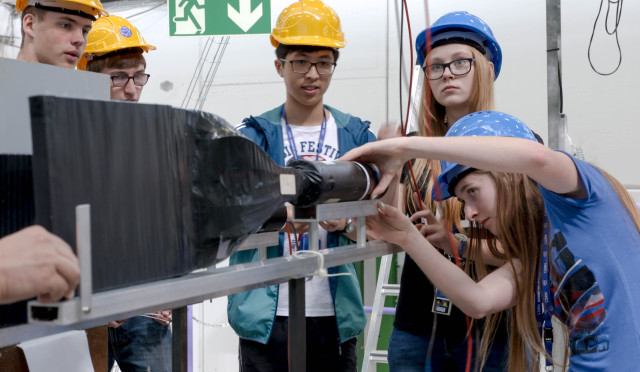Two teams of high-school students from the UK and Poland had the opportunity to conduct their own experiments at a fully equipped CERN beamline, after winning the third Beamline for Schools competition.
The teams, “Pyramid Hunters” from Poland and “Relatively Special” from the United Kingdom, spent 10 days at CERN conducting the experiments they had dreamt up in their winning proposals.
The Beamline for Schools competition gives high-school students the chance to run an experiment on a fully equipped CERN beamline, in the same way researchers do at the Large Hadron Collider and other CERN facilities every day.
The two teams, totaling 16 students, were selected out of 151 applications from 37 countries around the world, representing more than 1250 high-school students who engaged with particle physics as they worked on coming up with feasible experiments to test.

Pyramid Hunters is a team of seven students from the Liceum Ogólnokształcące im. Marsz. St. Małachowskiego. Their project involved measuring how limestone absorbs fundamental particle called muons. They hoped to use this knowledge to understand data from an old 3D image made of the Chephren pyramid using a technique called muon tomography. The technique builds images in a similar way to a CT scan, but muons are used as they can penetrate through thicker material than X-rays.
“It’s been a great experience and also a great chance to contribute to other experiments and mix with other cultures,” says Kamil Krakowski, a member of the Pyramid Hunters team.
“CERN is like a city where even if people work hard and do a lot of research, they still have time to sit together and talk,” another member of team, Kamil Szymczak, explains.
Relatively Special, from Colchester Royal Grammar School, aimed to test the validity of the Special Relativity theory using the decay rate of particles called pions.

“Both teams worked for at least 12 hours per day and on some days it was not easy to get them out of the control room at 9 p.m. when the official shifts ended,” says Markus Joos, Beamline for Schools project leader. “The data they have collected will keep them busy for many weeks to come. Both teams are planning to write a scientific paper about their results.”
Dedicated CERN staff and users from across CERN departments were on site to guide the students through the experiment. “In the era of big experiments, it is a pleasure to prepare and conduct a few tiny, but educational experiments within a year, driven by curiosity and not by results,” says Oskar Wyszynski, one of the scientists who supported the teams.
Physicists, engineers and experts in several fields from across all CERN departments helped with the preparations for the experiment and offered guidance during the experimental phase at CERN. “I would like to thank the many colleagues at CERN who help us to organise the BL4S competition every year,” underlines Joos.
During their time at CERN, the students also spent a day undergoing training and safety awareness (see the Box) and visited many of CERN’s spectacular experiments and facilities, including CMS, ATLAS, the Antiproton Decelerator and the CERN Control Centre (CCC).

The students also had the opportunity to meet the supporters of the Beamline for Schools 2016 competition. Representatives from the Alcoa Foundation and National Instruments met with the winning teams from the UK and Poland, exchanged ideas and shared their passion for scientific education and advancement. The Motorola Solutions Foundation team, although not physically present due to scheduling conflicts, sent a message to the students.
Beamline for Schools is an education and outreach project funded by the CERN & Society Foundation, supported by individuals, foundations and companies. The project is funded in part by the Alcoa Foundation; additional contributions are received from the Motorola Solutions Foundation, the Fund Ernest Solvay managed by the King Baudouin Foundation, and National Instruments.
The fourth edition of BL4S has already been announced and proposals will be accepted until 31 March 2017.

